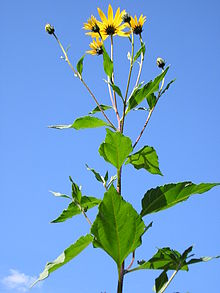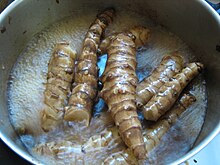Jerusalem artichoke
| Jerusalem artichoke | |
|---|---|
 |
|
| Stem with flowers | |
 |
|
| Jerusalem artichokes | |
| Scientific classification | |
| Kingdom: | Plantae |
| (unranked): | Angiosperms |
| (unranked): | Eudicots |
| (unranked): | Asterids |
| Order: | Asterales |
| Family: | Asteraceae |
| Tribe: | Heliantheae |
| Genus: | Helianthus |
| Species: | H. tuberosus |
| Binomial name | |
|
Helianthus tuberosus L. |
|
| Synonyms | |
|
|
| Nutritional value per 100 g (3.5 oz) | |
|---|---|
| Energy | 304 kJ (73 kcal) |
|
17.44 g
|
|
| Sugars | 9.6 g |
| Dietary fiber | 1.6 g |
|
0.01 g
|
|
|
2 g
|
|
| Vitamins | |
| Thiamine (B1) |
(17%)
0.2 mg |
| Riboflavin (B2) |
(5%)
0.06 mg |
| Niacin (B3) |
(9%)
1.3 mg |
| Pantothenic acid (B5) |
(8%)
0.397 mg |
| Vitamin B6 |
(6%)
0.077 mg |
| Folate (B9) |
(3%)
13 μg |
| Vitamin C |
(5%)
4 mg |
| Minerals | |
| Calcium |
(1%)
14 mg |
| Iron |
(26%)
3.4 mg |
| Magnesium |
(5%)
17 mg |
| Phosphorus |
(11%)
78 mg |
| Potassium |
(9%)
429 mg |
|
|
|
|
|
| Percentages are roughly approximated using US recommendations for adults. Source: USDA Nutrient Database |
|
The Jerusalem artichoke (Helianthus tuberosus), also called sunroot, sunchoke, earth apple or topinambour, is a species of sunflower native to eastern North America, and found from eastern Canada and Maine west to North Dakota, and south to northern Florida and Texas. It is also cultivated widely across the temperate zone for its tuber, which is used as a root vegetable.
Helianthus tuberosus is a herbaceous perennial plant growing to 1.5–3 m (4 ft 11 in–9 ft 10 in) tall with opposite leaves on the upper part of the stem but alternate below. The leaves have a rough, hairy texture. Larger leaves on the lower stem are broad ovoid-acute and can be up to 30 cm (12 in) long. Leaves higher on the stem are smaller and narrower.
The flowers are yellow and produced in capitate flowerheads, which are 5–10 cm (2.0–3.9 in) in diameter, with 10–20 ray florets and 60 or more small disc florets.
The tubers are elongated and uneven, typically 7.5–10 cm (3.0–3.9 in) long and 3–5 cm (1.2–2.0 in) thick, and vaguely resembling ginger root in appearance, with a crisp texture when raw. They vary in colour from pale brown to white, red, or purple.
Before the arrival of Europeans, Native Americans cultivated Helianthus tuberosus as a food source. The tubers persist for years after being planted, so that the species expanded its range from central North America to the eastern and western regions. Early European colonists learned of this, and sent tubers back to Europe, where it became a popular crop and naturalized there. It later gradually fell into obscurity in North America, but attempts to market it commercially have been successful in the late 1900s and early 2000s.
...
Wikipedia
